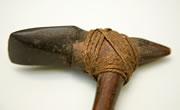 An adze from the Cook IslandsJane Willcock, Anthropology Museum, The University of Queensland
An adze from the Cook IslandsJane Willcock, Anthropology Museum, The University of QueenslandThe discovery of an adze fashioned from Hawaiian basalt on a Tuamotu atoll in French Polynesia provides the first material evidence that ancient voyagers made an 8,000-kilometre round trip from the South Pacific to Hawaii and back again.
More than 2,000 years ago, seafarers from Samoa and Tonga ventured eastward to settle on more remote archipelagos in the Pacific Ocean, including the Cook Islands, Tahiti, and the Marquesas Islands, colonizing most of these places by 900 AD. Eventually, the travellers set foot on Hawaii.
Scientists have long thought that these journeys must have been accidental or one-time events, but recent research has hinted that these peoples were capable of greater feats of navigation than previously suspected. Despite this, there has been debate about how much travel and trade took place among these remote islands in eastern Polynesia during the early years of their colonization; did those settlers who made it to Hawaii ever travel back again?
Hawaiian oral histories point to voyages to and from Tahiti, but in the absence of evidence these feats have remained the stuff of legends.
Volcanic origins
Kenneth Collerson and Marshall Weisler at the University of Queensland, Australia realized that one way to test this possibility was to trace the origins of 19 adzes — axe-like tools made from stone that were used for carving canoes and other wooden objects — that had been recovered from coral atolls in the Tuamotus in the late 1930s.
Because the adzes are fashioned from basalt — an igneous rock — they must have been transported from one of the many volcanic island chains in the region, possibly even Hawaii. Because the Tuamotus rose from the sea only after 1200 AD, the adzes provide a record of travel from after that time.
Collerson, a geochemist who studies mantle processes, knew that basalts from different types of islands have a distinctive signature in their trace elements and isotope chemistries. So the team took centimetre-wide chunks from the adzes and compared them to a database they had compiled from sites throughout the Pacific.
Although the Society Islands would have been the nearest source for basalt, the team identified adzes from the Marquesas, Pitcairn, and the Austral islands, indicating extensive travel in the region. One adze had been fashioned from hawaiite, specifically from the island of Kaho'olawe. Collerson says that "the only other possible location on the planet where it could have come from is one of the islands in the middle of the Atlantic" — an extremely unlikely prospect. They checked their result twice over two years before finally submitting their paper to Science, where it appears this week1.
Lonely Journey
Collerson and Weisler's study adds to a growing consensus among scientists about the impressive navigational capacities of ancient Polynesians. "They've really shown how wide a spread or distribution this trading network really had," says Patrick Kirch, an archaeologist at the University of California at Berkeley. "The clincher, of course, is the one from Hawaii."
Earlier this year, another group reported on the presence of Polynesian chicken bones in Chile, confirming that these voyagers made it as far as the New World sometime between 700 and 1390 AD.
ADVERTISEMENT
The adze finding is also welcome evidence to Geoffrey Irwin, an anthropologist at the University of Auckland, who became a major proponent of the theory that Polynesians systematically colonized the Pacific after following the settlement route himself in a sailboat. He points out that a group of anthropologists have also made the 1-month voyage from Tahiti to Hawaii navigating via celestial clues alone2.
The tip of Hawaii's Kaho'olawe Island is today known as Lae o Kealaikahiki, which means 'cape or headland on the way to Tahiti'. Collerson suggests that rock from this cape in particular may have been taken as a memento by travellers commemorating their long and arduous journey.
Visit our toolrevealslengthypol.html">newsblog to read and post comments about this story.
